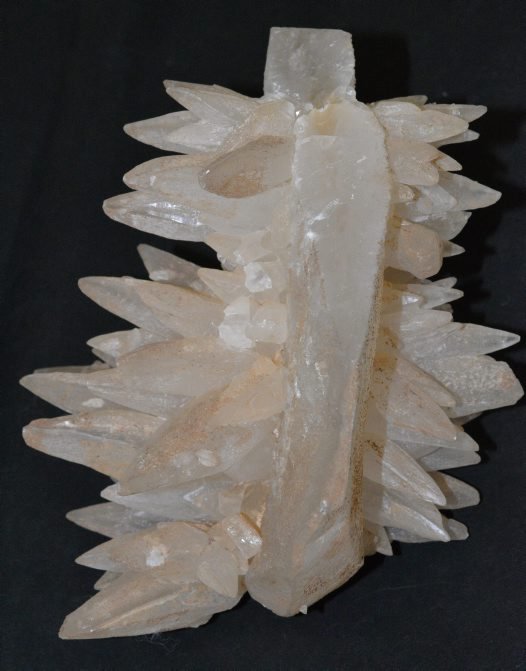A Cave Made to Order
The Australian Museum used to have its own richly-decorated limestone cave
People are fascinated by the beauty of limestone caves, with their exotic decorations, but not everyone has the opportunity to experience these natural wonders. This challenged the imagination of Thomas Hodge-Smith, Curator of Minerals at the Australian Museum. He wanted everyone to see what a decorated limestone cave looked like, so collected many cave formations from Cliefden Caves in central-western NSW to construct a remarkable replica which opened in 1936. Apart from limestone caves, the Cliefden region also has an interesting hot spring and an important fossil site, all of which were discussed at a special Symposium held at Bathurst in September.

© Australian Museum
I was an invited speaker at the Linnean Society of NSW Symposium “Natural History of the Belubula River Valley”, which described the plants, animals, landforms, Cliefden Caves, thermal spring and Fossil Hill fossil site in that region. This gave me a great opportunity to talk about the Australian Museum’s limestone cave replica and the unusual Cliefden cave formations in the Museum collection. I was accompanied by Interpretative Officer, Melissa Murray, who also attended the Symposium and later field trip to Fossil Hill.
Conferences and Symposia can be narrow-focussed specialist events, but this one had wider appeal and covered the entire natural environment of a region. The Cliefden Caves and Fossil Hill are about 30 km NE of Cowra and 50 km S of Orange, near the Belubula River. This river flows near the central-western NSW town of Carcoar, and also through Canowindra, where the Age of Fishes Museum is situated.
The Australian Museum has a long association with the Cliefden Caves, as Dr Charles Anderson, later Director of the Australian Museum visited there in 1917 and collected transparent, perfectly formed calcite (calcium carbonate) crystals. A spectacular calcite crystal group from the caves was presented in 1923 by Miss Judy Hosie, whose father owned a nearby property. This beautiful crystal group is still on display in the Museum.

© Australian Museum
My talk was a double act with Associate Professor Armstrong Osborne of Sydney University, who is also a Research Associate of the Australian Museum. I talked about the remarkable replica of a decorated limestone cave opened in 1936 at the Australian Museum, with cave formations collected from the Cliefden Caves in 1932 and 1934. This display resulted from a desire by Curator of Minerals Thomas Hodge-Smith to show city dwellers the wonders of a limestone cave without a long trip into the country, and was highly successful. It lasted until 1984, when the Mineral gallery was redeveloped and a simpler Limestone Cave installed, using some cave formations from the earlier display. This in turn was dismantled in 2010.

© Bruce Welch
During the talk we described unusual Cliefden cave formations in the Australian Museum collection, including large, transparent calcite (calcium carbonate) crystals from an ancient pool deposit, flat-faced ‘polyhedral’ stalactites, and profuse spiky calcite crystal overgrowths. Of special note are the pale blue aragonite (calcium carbonate) stalactites coloured by copper. Examples of these unusual cave formations from the Australian Museum collection were displayed as a special guest exhibit at the Australian Fossil and Mineral Museum at Bathurst.

© Australian Museum
The Symposium also had a field trip to the Fossil Hill site where Upper Ordovician fossils can be seen, including a remarkable shell bed representing a mass kill of the shellfish caused by suspected catastrophic storms. I gave up trying to negotiate the tricky 45 degree slopes on unstable rock rubble and scouted around the base of the hill (when the fossils erode out of the rocks they roll downhill anyway!). I was fortunate to find a very uncommon nautiloid fossil, along with shells and corals.
Not a bad outcome for a Mineralogist collecting fossils!
Ross Pogson, Collection Manager, Geosciences, Australian Museum Research Institute

© Australian Museum
Further Information:
- Anderson, C., 1920. Mineralogical Notes No. 10, in Records of the Australian Museum 13(1), 16 March 1920, 13-15.
- Anderson, C., 1924. A visit to the Belubula Caves. The Australian Museum Magazine, 2 (1), January 1924, 12-17.
- Hodge-Smith, T., 1936. A Limestone Cave in the Australian Museum. The Australian Museum Magazine, 6 (2), April-June 1936, 39-46.
- Osborne, R.A.L., 1978. Structure, sediments and speleogenesis at Cliefden Caves, New South Wales. Helictite, 16(1), 3-32.
- Pogson, R.E., and R.A.L. Osborne, 2015. A Cliefden Cave and Speleothems at the Australian Museum. Abstracts: Linnean Society of NSW Symposium “Natural History of the Belubula River Valley, & the adjacent area of central western NSW, including the Cliefden Caves and Fossil Hill”, 7 – 10 September 2015.
- Trickett, O., 1908. Report of the Cliefden Caves, Warm Spring and Fossil Hill, Belubula River. Annual Report of the Department of Mines NSW, 1908. 172.
- Turner, K., 2002. Chromophores producing blue speleothems at Cliefden, NSW. Helictite, 38(1), 3-6.
- Wilkinson, C.S., 1892. Description of the Belubula Caves, Parish of Malongulli, Co. Bathurst. Records of the Geological Survey of New South Wales 3(1), 1-5.

